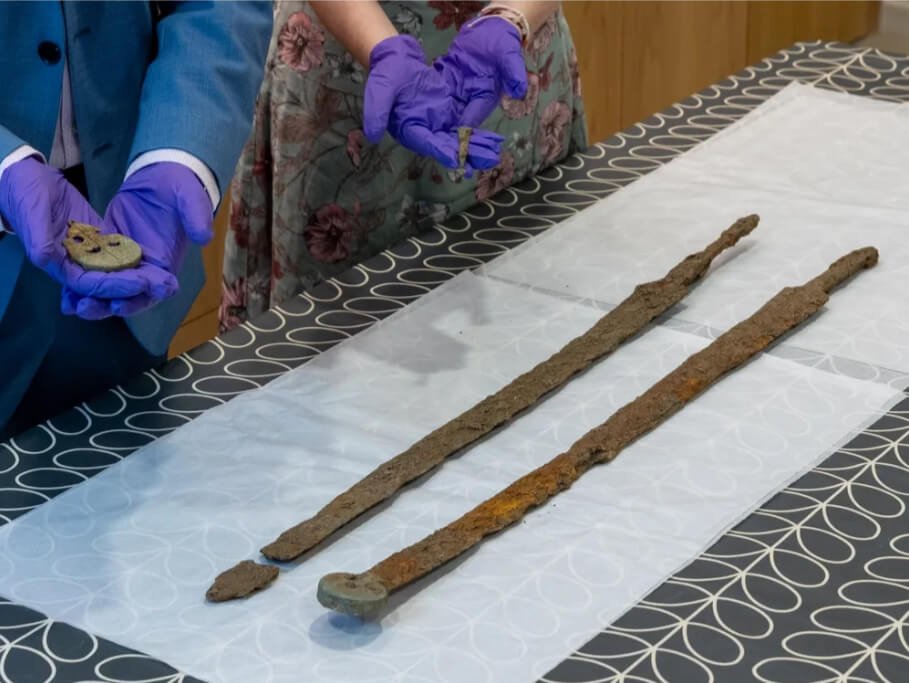
The swords have long blades that were likely used by Roman soldiers or civilians while riding on horseback. Cotswold District Council
In an astonishing discovery, a metal detectorist by the name of Glenn Manning unearthed a pair of 1,800-year-old Roman cavalry swords in the North Cotswolds region of southern England. These remarkable swords, still encased in the remnants of their wooden sheaths, provide a fascinating glimpse into the martial history of Roman Britain. The find has ignited excitement among archaeologists and historians, who are eager to unravel the secrets concealed within these ancient blades.
The swords, with their long and slender blades, are believed to be of the type known as a “spatha.” Roman soldiers and even civilians often carried such weapons while riding on horseback during the Roman Empire’s heyday, from around 160 to the third century C.E. This practice was not unusual, as Roman provinces were frequently plagued by banditry, making it entirely legal for civilians to possess and carry such weapons for their protection during travel.

Paul Hodgkinson, a Cotswold District Council member responsible for leisure, culture, and health, aptly pointed out the historical significance of this find by saying, “People famously asked, ‘What have the Romans ever done for us?’ Well, they have just given us some amazing examples of weapons used almost 2,000 years ago when Cirencester was the second biggest town in Britain.” Indeed, this discovery adds another layer to the rich tapestry of Roman influence in Britain.
One notable feature of the spatha swords is their elongated, straight blades. This design made them particularly suited for Roman officers and riders, allowing them to wield the weapon effectively while on horseback. Compared to the more famous Roman gladius, which was a shorter sword typically used by foot soldiers, spatha swords catered to the needs of equestrian soldiers.

What makes this discovery even more intriguing is the rarity of finding multiple Roman swords together in Britain. Simon James, an archaeologist at England’s University of Leicester who analyzed the swords, noted, “In terms of parallels, I can’t think of finds of more than one sword being deposited in any similar circumstance from Roman Britain.” He goes on to mention a comparable find in Canterbury, where a pair of similar swords were discovered alongside their owners in a clandestine burial, most likely the result of a double murder.
To gain deeper insights into the swords’ history, archaeologists are planning to take X-rays of the artifacts and revisit the site where they were found. Additionally, in close proximity to the swords, Glenn Manning also discovered a broken bowl made of copper alloy. These additional finds could potentially shed light on the context of the swords’ burial.

Emma Stuart, director of the Corinium Museum in Cirencester, England, expressed the curiosity surrounding this discovery, stating, “The question is—and the mystery is—why were those swords buried in the north of the Cotswolds? What were they doing there?” These are questions that researchers hope to answer in the coming months as they delve deeper into the historical significance of these ancient Roman cavalry swords.
This remarkable discovery in England is not the only recent find of Roman-era swords. Earlier in the summer, archaeologists in Germany uncovered the remains of a Frankish medieval warrior buried with a 1,300-year-old spatha. Just last month, the Israel Antiquities Authority announced the discovery of four 1,900-year-old Roman-era swords in a cave near the Dead Sea. Three of these swords resembled the spatha with their long blades, while the fourth was a shorter ring-pommel sword.
The unearthing of these ancient swords serves as a vivid reminder of the enduring fascination with the Roman Empire and its legacy, which continues to captivate both historians and the general public alike. As researchers work to unravel the mysteries surrounding these relics, they provide us with a tangible connection to a distant past and a deeper understanding of the Roman presence in ancient Britain. These swords, now under the care of archaeologists, are poised to reveal more of their secrets and enrich our understanding of history in the years to come.